
|
 |
Junkers Ju 88 Schnellbomber |
 |
 |
 |
 |
 |
|---|---|---|---|---|---|---|---|
 |
 |
 |
 |
 |
|||
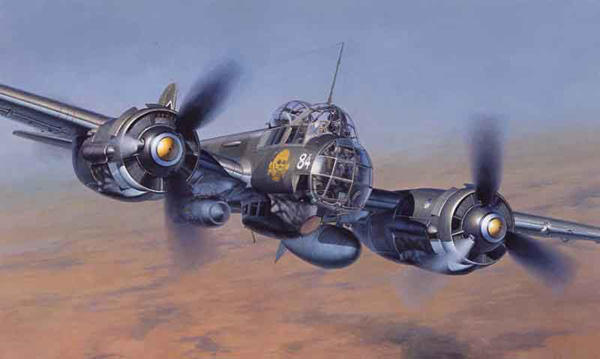 |
|||||
|
In versatility and performance, the Junkers Ju 88 could be compared to the British
de Havilland Mosquito or in some aspects, the
North American B-25 Mitchell. In any event, approximately 15,000 aircraft were produced in various forms from 1939 to 1945. An astonishing 104 prototypes and dozens of variant were built, with more than 9,000 produced as bombers. It had flexibility and was the most modifiable aircraft during the war. It was said to be easy to fly with good handling, highly maneuverable and responsive. It was without a doubt, the finest German bomber to see extensive service throughout the war.
First designed as a high speed bomber, it was the backbone of the German Luftwaffe and served in the following roles: | |||||
| • Horizontal bomber. | • Dive-bomber. | ||||
| • Torpedo bomber. | • Heavy fighter. | ||||
| • Night-fighter. | • Attack aircraft. | ||||
| • Reconnaissance aircraft. | • Communications aircraft. | ||||
| • Mine layer. | • Flying bomb. | ||||
| In early 1935, the German Ministry of Aviation (Reichsluftfahrtministerium, or RLM) met with the chief German aircraft designers in Berlin and issued specifications for a three-seat, Schnellbomber or a high-speed medium bomber with a payload of 800-1,000 kg (1,760-2,200 lb) and fast enough to outrun any available fighter at the time—its high speed would be part of its defensive capability. Dornier and Heinkel were already committed to projects and proposals were submitted by Focke-Wulf, Messerschmitt and Junkers. Fock-Wulf submitted the Fw 57, but it was seriously overweight due to their inexperience in all-metal construction. Messerschmitt submitted the Bf 162, but it was decided that they should concentrate their efforts on fighter designs. Basically, the contract was given to Junkers by default, who was then awarded a production contract for the Ju 88. |
| Oddly enough, the Ju 88 has American roots. It was designed by a USA citizen Alfred Gassner and W. H. Evers who had spent time in the United States working for American aircraft manufactures. Both were employed by Junkers to design the new bomber and work was initiated on January 15, 1936. The prototype was scheduled to be completed in nine months and the inaugural flight of the Ju 88V1, which bore the civil registration D-AQEN, was flown on December 21, 1936, by Junkers chief test pilot Flugkapitän Kinderman. Upon completion of the prototype, Alfred Gassner returned to the United States and W. H. Evers was pushed to the side and never given any official recognition for his part in the creation of the aircraft. |
|
The aircraft that emerged was a twin-engine medium-bomber that would differ appreciably from its successors. The cockpit was only slightly higher than the fuselage, the landing gear featured twin oleo struts that retracted into the engine nacelles and it was powered by two
Daimler Benz DB 600 engines. The engines appeared to be air-cooled radials because of the circular nacelle design, but this was to accommodate annular segmented oil and coolant radiators and it also allowed for various engines to be installed depending upon availability.1
The Ju 88V1 was destroyed after only a few test flights, but the Ju 88V2 became available shortly after on April 10, 1937, and the Ju 88V3 appeared on September 13, 1937. The Ju 88V2 attained a maximum speed of 289 mph, making it faster than the early Messerschmitt bf 109s, which was initially required to reach only 250 mph (401 km/h). The range was 1,242 miles (2,000 km), it had a service ceiling of 19,685 feet 6,000 m) and could carry a bomb load of 1,102 lbs (500 kg). The majority of fighters at the time were still biplanes with a maximum speed of approximately 200 mph (320 km/h), making the speed of the Ju 88 appreciably higher.2 The Ju 88V3 would be the first aircraft to be equipped with the Junkers Jumo 211A, which would power the majority of subsequent production aircraft. It would also have an extensively redesigned cockpit that was raised above the fuselage with a gondola under the nose to the starboard side, with a gunner lying prone firing a MG 15 machine gun. The Ju 88V4 increased the crew to four from three and it was on this version that the “beetles eye” flat panels appeared on the nose.
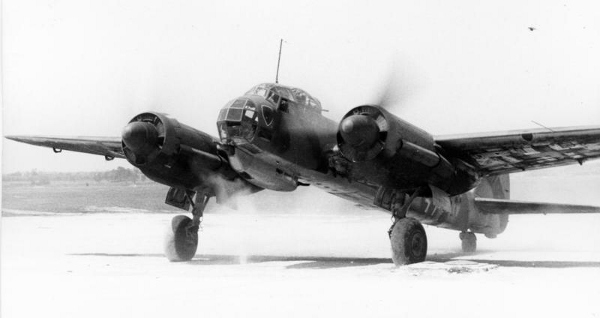
The Ju 88V5 was a cleaned up version built to set a series of record breaking flights. It had a streamlined nose and was powered by two Jumo 211B-1 engines. In March 1939, it flew at an average speed of 321 mph (517 km/h) in a 621 mile (1,000 km) closed circuit carrying a payload of 4,400 lbs (2,000 kg). Four months later it averaged 311 mph (500 km/h) and covered a distance of 1,242 miles (2,000 km). The Ju 88V6 would become the production model for the A series. The landing gear was changed to a single oleo strut that rotated 90 degrees when retracted into the engine nacelle. It was powered by a Jumo 211B-1 engine, and had a maximum speed of 301 mph (485 km/h). The range was 1,522 miles (2,450 km) and had a service ceiling of 22,300 ft (6,800 m). The Ju 88V7 (Ju 88C) would be the first Zerstörer, or heavy fighter, and was armed with two 151 MG cannons and two MG 17 machine guns housed in a solid nose. It was also was fitted with cable-cutting equipment as a defense against British barrage balloons, which proved to be highly effective. Production of the A series began in 1939, but initial production was slow due to developmental problems. Dr. Heinrich Koppenberg, the managing director of Jumo, assured Herman Göring that 300 Ju 88s could be delivered per month. Operational service was expected to start in 1938, but the Ju 88 entered service with only 12 available aircraft on the first day of the attack on Poland on September 1, 1939. However, by the end of 1940, 1,816 bombers, 330 reconnaissance and 62 heavy fighters were produced.
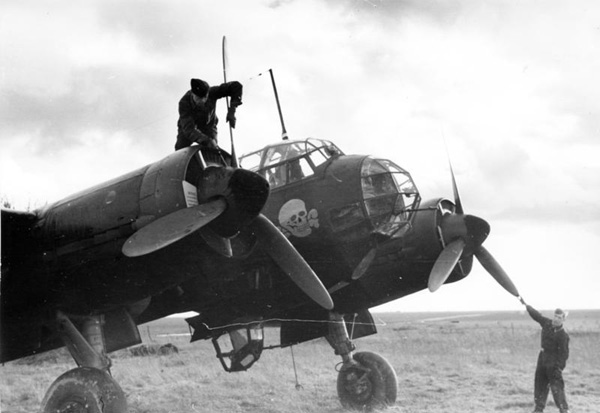
With the introduction of the newly designated Ju 88A-4, the wing span was increased by six feet to 65 ft. 10-1/2 inches and defensive armament was substantially increased. A typical arrangement consisted of forward firing MG 31 and MG 81 machine guns, two MG 81s or one MG 131 aft firing machine guns and one MG 81 in the ventral position. Armor protection for the crew was increased and the landing gear was strengthened. Provisions were made for Rocket Assisted Takeoff in order to raise the bomb load to 6,614 lbs (3,000 kg). The Ju 88A-4 retained the Jumo 211B-1 engines, but the Ju 88A-4/R which began production in 1942 switched to 1,440 hp (1,075 kw) Jump 211J engines. The maximum load was increased to 31,000 lbs (14,050 kg), but due to the added weight, the maximum speed was reduced to 273 mph (440 km/h). In 1940 During the “Battle of Britain”, the Ju 88 fared better than most other German aircraft, but the war experience exposed a number of shortcomings and modifications were necessary. This became evident on October 9, 1939, when one Ju 88 had the dubious honor of becoming the first victim of RAF fighters. It was the best German bomber, but without fighter escort, it still suffered from heavy losses during missions originating from bases in Norway. In the third week of the war, four Ju 88A-1s attacked British warships at Scapa Flow, but they caused no damage. The Ju 88B series did not enter production and only 10 pre-production Ju 88B-0s were built. It had a cleaner more streamlined fuselage with a more extensively glazed nose section. Due to a delay with the Jumo 213A engines, it was powered by two 1,600 hp (1190 kW) BMW 801A, air-cooled radial engines. Armament consisted of six 7.9 MG 81 and a bomb-load of 5,500 lbs (2,500 kg). The maximum speed was 311 mph (500 km/h) and it had a ceiling of 30,840 feet (9,400 m). It had a range of 1,555 miles (2,500 km) and the loaded weight was 26,014 lbs (11,800 kg). One of the Ju 88B-0s was fitted with a power-operated dorsal turret and was redesignated as the Ju 88E. This model served as the prototype for the Ju 188. The standard fighter, the Ju 88C-6, was introduced in 1942 and was powered by two Jumo 211J engines. The C-6a was the day fighter and the C-6b the night-fighter. The night-fighters were initially equipped with the FuG 202 Lichtenstein BC radar, which was later was replaced with a simplified FuG 212 Lichtenstein C-1 and in then in late 1943 with a Lichtenstein SN-2. Armament consisted of three forward firing MG 17 machine guns, one 20 mm MG FF/M cannon in the nose and twin 20 mm cannons in the gondola.
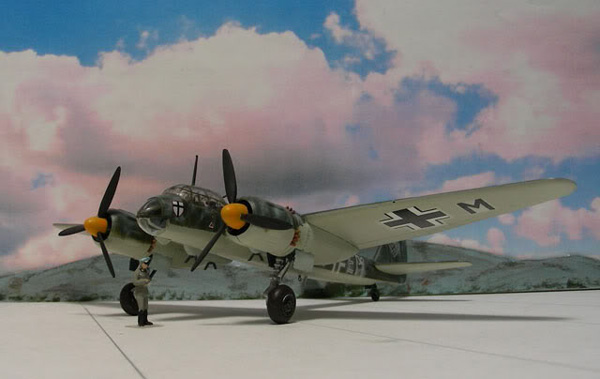 The Ju 88S had a streamlined glass nose and no gondola. In early 1943, a standard production Ju 88A-4 was used as the prototype for the Ju 88S series. It had a smooth rounded nose, the gondola was removed and it was powered by two BMW 801 radial engines. Armament consisted of one 13 mm MG 131 and three 7.9 mm MG 81 machine guns. The production model was the Ju 88S-1 and was powered by two 1,730 hp (1,290 kW) BMW 801G-2 engines with GM-1 nitrous oxide injection. The GM-1 nitrous oxide system provided additional oxygen for combustion, and was held under pressure in three tanks aft of the bomb-bay. However, a single hit in any single tank would cause a massive explosion. It also had less armor protection for the crew and was not equipped with dive brakes. Two 2,200 lb (1,000 kg) bombs were held on shackles on either side of the fuselage at the underside of the wing center section. The JU 88S-2 was powered by two 1,800 hp (1,340 kW) BMW 801TJ turbo-supercharged engines and was fitted with a wooden bulged bomb-bay. The JU 88S-3 was the same as the S-1 but was powered by two 1,776 hp (1,325 kW) Jumo 213A-12 engines that could be boosted up to 2,125 hp (1,585 kW) with the GM-1 system. Maximum speed with the GM-1 system was 382 mph (615 km/h) at 27,900 ft (8,500 m).
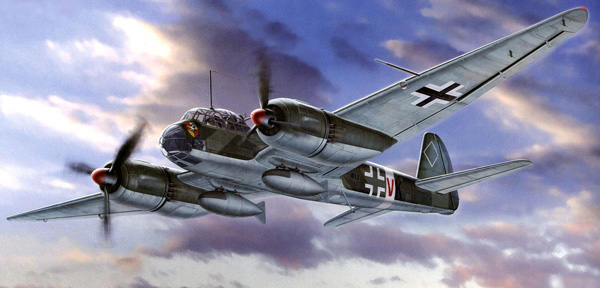 A reconnaissance Ju 88T with long-range fuel tanks. The Ju 88T was the reconnaissance version of the Ju 88S and was produced in parallel with the bomber. The Ju 88T-1 was similar to the S-1, but was equipped with either an Rb 20/30, Rb 50/30 or Rb 75/30 camera in the rear fuselage. There were three crew members and defensive armament consisted only of either one MG 131 machine gun or twin MG 81Z machine guns. The Ju 88T-3 was similar to the S-3 but did not go into major production. The Ju 88R-1 was basically a Ju 88C powered with two 1,600 hp (1,190 kW) BMW 801MA or BMW 801C engines. It used a similar radar arrangement as the C-6b. The JU 88R-2 was powered by two 1,700 hp (1,265 kW) BMW 801D engines and carried a Fug 217 Neptun R tail warning radar. Some R models were equipped with the Fug 227 Flensburg homing radar which was able to detect and home in on the emissions from British Lancaster “Monica” tail warning radar. Once the Germans discovered the Monica system, it was actually causing the loss of more British bombers than it was saving. On May 9, 1943, a Ju 88R-1 defected to Britain, landing near Aberdeen. Allegedly it was carrying an important agent, but the secrets of its Fug 200 Lichtenstein SN-2 radar and Fug 227 Flensburg homing radar were also extremely valuable. Bomber Command examined the German radar and removed all the Monica sets from all of its Lancasters. Bomber Command was also able to introduce a new type of ‘Window’ or chaff to jam the SN-2 radar. Armament consisted of three MG 17 machine guns, two MG FF and one 20 mm MG 151.20 cannon.
 A Ju 88G-6 equipped with Schräge Musik upward-firing cannons. The Ju 88G replaced the C and R on the production lines and was the most effective German night-fighter. It had extended wingtips and rectangular tail surfaces. It was powered by two BMW 801D engines and armed with four 20mm MG151/20 cannon in the ventral gondola. Two more cannons were usually placed in the dorsal position, firing diagonally upwards and forward, which was known as Schräge Musik. Schräge Musik was the name for upward-firing autocannons mounted in night fighter aircraft and attacked Allied bombers from below and aft of the bomber's field of view. It was extremely effective against British Lancasters, because they lacked ventral guns. The Ju 88G-6 was powered with Jumo 213 engines and entered service in the late 1944. On July 13, 1944, a Ju 88G-1 landed on a RAF base, after a navigation error, and gave away all the secrets of its Lichtenstein SN-2 radar, and Flensburg and Naxos radar detectors. The Ju 88D, Ju 88H, and Ju 88T were reconnaissance versions. The Ju 88D was based on the A-series and the T on the S-series. The Ju 88H was more extensively modified. The Ju 88H-1 was intended for long-range naval reconnaissance, carrying radar. The Ju 88H-2 was a more offensive version, with six forward-firing MG151/20 cannon. The Ju 88H-3 was further extended to achieve an even longer range. Small numbers of these were built. The Ju 88P was an anti-tank version and built in several versions in limited numbers. The Ju 88P V1 was a modified Ju88A-4 equipped with a 75 mm KwK 39 armored-car cannon housed in a very large fairing beneath the fuselage. It could fire two rounds during each pass and was tested against a Russian T-34 tank and proved to be fairly successful. The first production model was the Ju 88P-1 and had the nose of the Ju 88C and armor protection for the engines and improved 75 mm PaK 40L anti-tank cannon. The cannon was semi-automatic and required one crew member to load the cannon. The total crew was three men. This version proved to be too unwieldy and vulnerable to attacks by fighter aircraft. The P-2 was armed with two 37mm cannons, a 50mm cannon, or even a 75mm cannon in a ventral gondola with the barrels offset to port, but the recoil was too powerful. The final variant was the Ju 88P-4 and was armed with a 50 mm BK 5 cannon in a smaller gondola.

The strangest version was of the Ju 88 was as the Mistel (Mistletoe) composite bomber. It was a combination of either a Messerschmitt bf 109 or Focke-Wulf Fw 190 riding piggyback on a Ju 88A-4. Testing began in July 1943 and the Mistel was ready by October. A pilot flew in the upper aircraft and when it was near the target, the Ju 88 would be guided by the pilot and released at the last minute. The Mistel could be flown on either two or three engines, depending on the range of the mission. Because of their lack of defense, all Mistel missions were operated at night. In order to place the fighter aircraft on top, considerable strengthening and modifications had to be completed on the lower bomber. The nose on the lower aircraft was replaced with a 7,715 lb (3,500 kg) warhead of 70% Hexogen and 30% TNT. Once over the target, the lower aircraft was released by explosive bolts and an impact fuse would be armed three seconds after release. A successful attack was made against the French Battleship Oran late in 1943. Other targets included British shipping, bridges to stop the Allied advance, and Soviet power stations, but bombing results were mixed. Approximately 140 Ju 88 Mistels were produced.3 Of the 15,000 Ju 88s built, there are only two complete surviving aircraft left. Several wrecks have been found in Norway and the in the former eastern bloc and are currently under restoration One intact survivor is a Ju 88R-1 at the RAF museum at Hendon and the other is a Ju 88D-1/Trop (later designated Ju 88D-3, known as the Baksheesh, at the National Museum of the U.S. Air Force in Dayton, Ohio.

The captured RAF Ju 88R-1 was a night-fighter version that was flown from Norway to Scotland in May 1943 after two members of its crew were persuaded to defect by British Secret Service agents. This aircraft was equipped with the latest FuG 202 Lichtenstein BC A.I radar. It was the first to fall into British hands with complete documentation and it provided valuable information about German electronic defenses to the RAF Bomber Command.
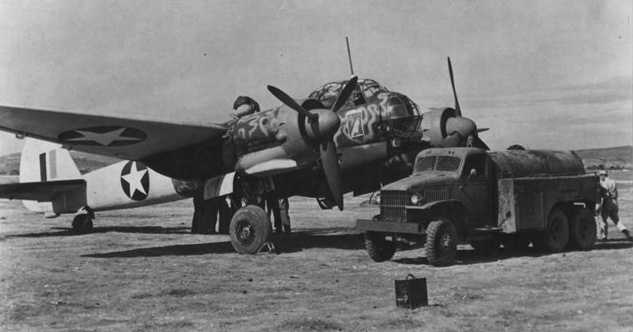
The captured USAAF Ju 88D-1/Trop was a long-range photographic reconnaissance version modified for tropical use. It was assigned to the Romania Air Force and flown to Cyprus after the Romanian pilot defected to the British. The RAF turned the aircraft over to the USAAF and it was tested at Wright Field. At the end of WWII, it was stored in the Arizona desert and in January 1960, it was shipped to the USAF museum. |
| Specifications: | |||
|---|---|---|---|
| Junkers Ju 88A-4 | Junkers Ju 88G-7b | Junkers Ju 88S-1 | |
| Dimensions: | |||
| Wing span: | 65 ft 7-1/2 in (20.00 m) | 65 ft 7-1/2 in (20.00 m) | 65 ft 7-1/2 in (20.00 m) |
| Length: | 47 ft 2-3/4 in (14.40 m) | 51 ft 2-1/2 in (15.58 m) | 48 ft 8-2/3 in (14.85 m) |
| Height: | 15 ft 11 in (4.85 m) | 15 ft 11 in (4.86 m) | 15 ft 8-1/2 in (4.80 m) |
| Weights: | |||
| Empty Weight: | 21,737 lb (9,860 kg) | 18,300 lb (8,300 kg) | |
| Loaded Weight: | 26,680 lb (12,100 kg) | 28,885 lb (13,100 kg) | 30,430 lb (13,800 kg) |
| Performance: | |||
| Max. Speed: | 292 mph (470 km/h) @ 17,390 ft (5,300 m) |
389 mph (686 km/h) @ 29,529 ft (9,000 m) |
341 mph (559 km/h) @ 26,250 ft (8,000 m) |
| Service Ceiling: | 26,900 ft (8,200 m) | 32,810 ft (10,000 m) | 34,450 ft (10,500 m) or 37,730 ft (11,500 m) with GM-1 |
| Normal Range: | 1,112 miles (1,790 km) | 1,398 miles (2,250 km) | |
| Max. Range: | 1,696 miles (2,730 km) | ||
| Powerplant: |
Two 1,340 hp (1,000 kW) Junkers Jumo 211J-1 or J-2 engines. |
Two 1,800 hp (1,342 kW) Junkers Jumo 213E with MW-50 boost. |
Two 2,125 hp (1,585 kW) BMW 801G-2 with GM-1 boost. |
| Armament: | Two MG 131 machine guns and two MG 81 machine guns. |
Two MG 151/20 cannon as Schräge Musik. |
One MG 131 machine gun. |
| Bomb Load: | Four 1,100 lb (500 kg) externally or ten 110 lbs (50 kg) internally. |
Two 2,205 lb (1,000 kg) externally. | |
Endnotes:
|
1. William Green. Famous Bombers of the Second World War. Garden City, New York: Hanover House, 1959. 71. 2. David Mondey. The Concise Guide to Axis Aircraft of World War II. New York: Smithmark Publishers, 1996. 119. 3. J. R. Smith, Anthony L. Kay and E. J. Creek. German Aircraft of the Second World War. London: Putnam & Company Ltd., 1985. 570-578. |
©Larry Dwyer. The Aviation History Online Museum.
All rights reserved.
Created September 21, 2014.